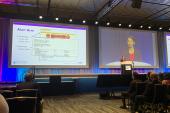Daily Texts Boost Self-care in HFrEF but Don’t Impact Outcomes
The current strategy deserved testing, but improving care for patients after an HF hospitalization has proved elusive.

Daily text messaging with patients after a hospitalization for heart failure with reduced ejection fraction (HFrEF) may help improve some elements of self-care but does not translate into meaningful differences in outcomes compared with usual care, according to the MESSAGE-HF trial.
“Patient education, self-care, and active engagement are important features of HF care, but our findings suggest that their modulation in the [transition] of care after hospital discharge might not be sufficient to improve short-term prognosis,” write Luis E. Rohde, MD, ScD (Hospital Moinhos de Vento, Porto Alegre, Brazil), and colleagues in a paper published December 6, 2023, in JAMA Cardiology.
Despite having higher scores on a self-care assessment and having frequent interaction with healthcare staff as needed, patients who received the daily text messages did not see a reduction in N-terminal pro-brain natriuretic peptide (NT-proBNP) levels at 180 days compared with patients who received usual care.
Rohde and colleagues suggest that in the period after an admission for acute decompensated HF, the focus should instead be on things like high-intensity optimization of guideline-directed medical therapy (GDMT), which was recently shown to be effective in the STRONG-HF trial.
“It’s so important that this was tested in a randomized trial as opposed to a before-and-after study, or just looking at a few patients, or assuming that it works,” said Gregg Fonarow, MD (University of California, Los Angeles), who was not involved in MESSAGE-HF. “It is very challenging to improve the care of these vulnerable patients who have been hospitalized with heart failure in a way that translates to improved outcomes, and while there have been a host of clinicians, disease management companies, and technology companies that have touted different care strategies [claiming] that they would improve care and outcomes, having rigorous clinical trial evidence has been few and far between.”
To TCTMD, Fonarow said that everyone agrees there need to be novel, patient-friendly ways to improve on usual care, but MESSAGE-HF is the latest in a host of telemonitoring ideas that sound good, but don’t deliver on outcomes.
‘Red Flags’ Were Frequent
For MESSAGE-HF, Rohde and colleagues randomized HFrEF patients from 30 clinics in Brazil to the telemonitoring group (n = 352) or to the standard-care group (n = 347). The mean age was 61.2 years and 34% were female. More than 80% had NYHA class II or III symptoms, with a median left ventricular ejection fraction of 28%. Most patients in both groups were optimized on GDMT at the time of randomization.
In the intervention group, patients received four daily text messages in the first 30 days. The content ranged from information about HF signs and symptoms, daily activities and lifestyle, correct use of medications, and fluid intake to inquiries from clinic staff about weight, night symptoms, and medication use. Depending on how patients answered, automatic diuretic adjustments or a telephone call from the nurse-led healthcare team might be made. These automated “red flags” included situations such as self-reported lack of medication adherence, rapid weight gain, and nighttime symptoms such as dyspnea. If patients were considered stable after the first month, the frequency of the text messages could be reduced from daily to three times a week.
The usual-care group received an educational self-care booklet that was also provided to the intervention group and had their regularly scheduled outpatient visits.
At 180 days, the degree of change in NT-proBNP from baseline (primary endpoint) was similar in the intervention and usual care groups (P = 0.39). A hierarchical analysis using the win ratio also failed to show any differences. There also were no differences seen in subgroup analyses of the primary endpoint.
HF-related self-care, a secondary endpoint, was assessed using the European Heart Failure Self-Care Behavior scale, with scores ranging from 12 (better self-care) to 60 (worse self-care). At baseline, scores were similar in the two groups, with a mean of 28. At 30 days, mean scores were lower in the telemonitoring group than the standard-care group (mean 22.4 vs 24.7; P < 0.001), and they remained lower at 180 days (mean 22.2 vs 24.5; P = 0.004). Daily weight, amount of daily fluid intake, adherence to medication, and receipt of flu vaccine were among the items that improved the most.
Total mortality or hospitalization for HF, another secondary endpoint, was similar in the telemonitoring and standard-care groups (HR 0.94; 95% CI 0.66-1.27).
About 12% of patients had automatic furosemide adjustment that was triggered by their response to text messages. Overall, the authors reported that patients in the intervention group were satisfied with the texting strategy and were reachable when healthcare staff needed to contact them by phone when responding to a red flag.
Looking to STRONG-HF and Combination Strategies
According to Rohde and colleagues, a number of things may explain why MESSAGE-HF did not have an impact on outcomes.
“As each center involved in the trial was trained to comply with different features of the telemonitoring intervention, it is conceivable that the control group was partially contaminated and did not represent genuine usual care,” they write. “Telemonitoring strategies depend on feasibility, acceptability, and responsiveness. Although unlikely, we cannot assure that heterogeneity in responsiveness at different centers might have influenced our results.”
Fonarow added that some of the things that telemonitoring strategies like MESSAGE-HF have included in their protocols have not been shown to be successful in conveying physiologic benefits in HF patients, including changes in weight and intensive self-care education.
Overall, he said he agrees with the study authors that the STRONG-HF model of intensive GDMT optimization has good evidence showing that it is effective in vulnerable HF patients transitioning from a hospital stay. Those data are also backed up by a recent economic modeling analysis by Fonarow’s group showing that it would be cost-effective and could result in gains in clinical outcomes, particularly with application of the “four pillars” approach.
“It doesn't mean that there are not other strategies that could be tested. In fact, combining a computer algorithm rather than just adjusting diuretics could help guide patients on the uptitration of their guideline-directed medical therapies. That is a strategy that could definitely be worth testing,” Fonarow said. It’s also possible that evolving technology could help physicians monitor more-actionable parameters, although that will require the kind of multicenter testing that was done in MESSAGE-HF to understand how and when to intervene in a way that makes an impact on outcomes, he added.
L.A. McKeown is a Senior Medical Journalist for TCTMD, the Section Editor of CV Team Forum, and Senior Medical…
Read Full BioSources
Rohde LE, Rover MM, Hoffmann Filho CR, et al. Multifaceted strategy based on automated text messaging after a recent heart failure admission: the MESSAGE-HF randomized clinical trial. JAMA Cardiol. 2023;Epub ahead of print.
Disclosures
- Rohde reports having received personal fees from Aché, AstraZeneca, Bayer, Boehringer Ingelheim, Merck Serono, and Novartis.
- Fonarow reports having consulted for Abbott, Amgen, AstraZeneca, Bayer, Boehringer Ingelheim, Cytokinetics, Eli Lilly, Johnson & Johnson, Medtronic, Merck, Novartis, and Pfizer.




Comments